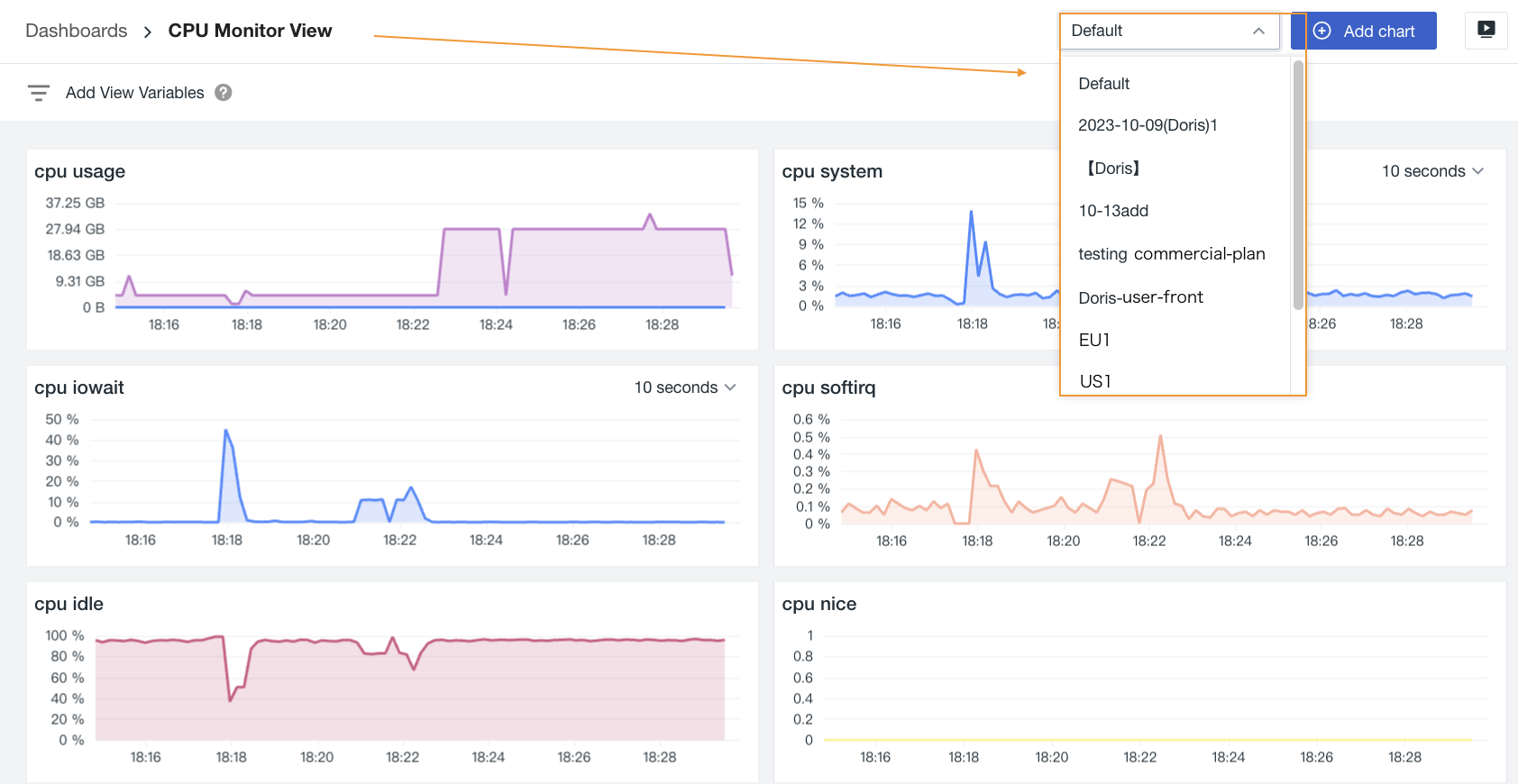Dashboard Management¶
After entering a specific dashboard, you can manage the dashboard through the following operations.
Card Attribute Information¶
After entering a specific dashboard, you can view and modify the dashboard's ID, name, description, tags, and visibility range at the metadata section at the top of the page. You can also delete the dashboard here.
Note
If the current dashboard page is saved as a snapshot and shared externally, the shared person cannot view the card attribute information here in a non-logged-in state.
Add Charts¶
After the dashboard is created, you can add charts. After selecting a chart, click "Complete Addition" at the top of the page.
Grouping¶
You can also categorize the charts within the dashboard.
- Click on Grouping;
- Enter the group name;
- Select the group color as needed;
- Confirm.
To modify this group, hover and click the settings button on the right.
Full Screen Mode¶
Click the "Full Screen" button, and the system will collapse the left and top navigation bars to display the view in full screen. Press the ESC button to exit.
Auto Refresh¶
Helps to quickly obtain real-time dashboard data. Optional frequencies: 5s, 10s, 30s, 1m, 5m, 30m, 1h.
If auto refresh is not needed, select Off (turn off).
Note
All dashboards and views share the same refresh configuration.
Settings¶
After the dashboard is created, click to perform the following operations on the dashboard.
Create Issue¶
You can create an Issue from the anomalies in the current dashboard.
For more details, refer to How to Manually Create an Issue at the View Level. For more information about Issues, refer to Incident.
Save Snapshot¶
- Enter the snapshot name;
- Select the visibility range;
- Select the time range, which will be automatically filled when the snapshot is opened again;
- Confirm.
In addition to opening the save page through the button, you can also use the shortcut (Windows: Ctrl+K / Mac OS: Cmd+K) to quickly save a snapshot. After saving, you can view it at Shortcut > Snapshots.
For more introduction, refer to Snapshot.
Save to Built-in View¶
- The view name defaults to the current dashboard name and can be modified;
- Select the binding relationship, such as
label:*; - Confirm.
Note
User views in the same workspace are not allowed to have duplicate names.
After saving, you can view the saved dashboard view "CPU Monitoring View" at Scenarios > Built-in Views > User Views.
Since the binding relationship label:* is set, the built-in view "CPU Monitoring View" can be viewed on the details pages of hosts and containers that have the "Label Attribute" set in the infrastructure settings.
Export/Import Dashboard JSON¶
You can export the current dashboard's JSON file or import a JSON file to overwrite the current dashboard. Once overwritten, it cannot be restored.
Clone Dashboard¶
- Enter the name of the copied dashboard;
- Select the visibility range of the dashboard;
- Confirm, and you can view the cloned dashboard in the dashboard list.
History Versions¶
The system will display the history operation records of the dashboard for the past three months.
Obsy AI Intelligent Analysis¶
With Obsy AI Intelligent Analysis, you can quickly interpret multi-dimensional metric views in the dashboard and detect faults. Without in-depth understanding of the data structure, directly ask questions, and the system will automatically retrieve key information and provide intelligent suggestions.
Note
- When the total number of charts in the dashboard exceeds 100 or the time widget selection range is greater than 3 days, this feature cannot be used;
- Currently, the chart types supported by Obsy AI Intelligent Analysis include: time series charts, bar charts, column charts, top lists, pie charts, overview charts, table charts, maps, and groupings.
Log Analysis¶
When performing view analysis within the dashboard, click "Log Analysis" to view and analyze related log data in a new side-slide page. To view in full screen, click "Log Analysis" again at the top of the side-slide page to jump to a new window's full-screen log explorer.
In the side-slide page, the log explorer will automatically bring in the dashboard's view variables as filter conditions, query according to the time range set by the dashboard, and display the log list data in standard mode.
Note
If the dashboard's view variable selection value is *, the log explorer will not display filter conditions by default.
Cross-Workspace Query¶
If the workspace is granted access to other workspaces, you can switch workspaces in the dashboard to view corresponding chart information.
Note
If the chart has already configured a workspace query configuration, its priority is higher than the global configuration.
Pin¶
When accessing a workspace that is authorized to view data from other workspaces, you can choose to pin the authorized workspace and set it as the default workspace for querying data.
Note
- Since only one workspace can be specified as the default option at a time, setting another workspace as the default option will invalidate the previously set default option;
- Supports canceling the pin of other workspaces. After canceling, the current workspace is used to fill in the query data by default;
- Read-only members do not support this operation.









